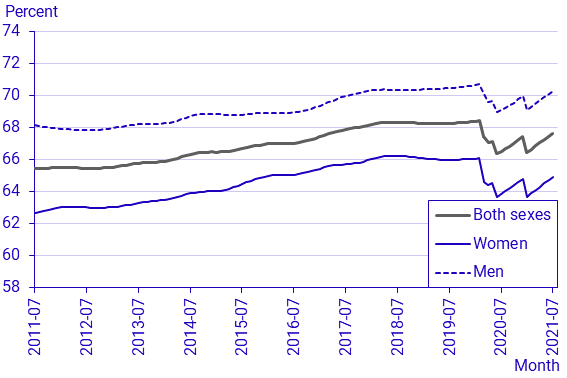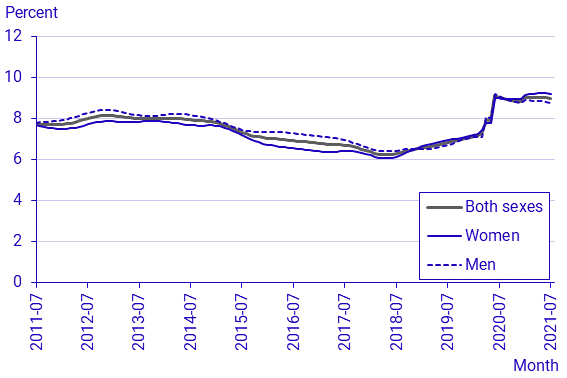Labour Force Surveys (LFS), July 2021
Employment continues to increase
Statistical news from Statistics Sweden 2021-08-26 9.30
In July 2021, 5 257 000 people were employed, not seasonally adjusted. There were 454 000 unemployed persons, which corresponds to an unemployment rate of 8.0 percent. The total average number of hours worked was 95.1 million hours per week. Seasonally adjusted and smoothed data showed that there were 5 078 000 employed persons in July, an increase compared with previous months in 2021. The unemployment rate was 9.0 percent, a decrease compared with previous months in 2021.
Caution should be used when interpreting the LFS outcome for July 2021. This is because labour market mobility is greater in the summer, combined with a higher non-response rate than normal.
Since 1 January, the Swedish LFS is in compliance with the new EU framework regulation on social statistics (Regulation (EU) 2019/1700 of the European Parliament and of the Council). This framework regulation has involved changes in the definition of employment, the sampling procedure, and the structure of the questionnaire. These changes have caused breaks in the time series and therefore, this item of statistical news does not include any comparisons with previous years. Comparisons with previous months in 2021 are possible for seasonally adjusted and smoothed data. However, comparisons with previous years are not advised. Throughout 2021, parallel measurements will be used to make it possible to link data backwards in time and make the series comparable with previous years.
The number of employed persons has been affected, partly due to the change in the definition; people who are completely absent from work for three months or more for certain reasons are no longer classified as being employed. Furthermore, new and updated information is used in the weighting procedures, which improves the precision in the estimates, although it also affects the levels of the number of employed persons. The change in the definition and the new weighting procedure led to a total estimated number of employed persons in July that is 54 000 fewer than according to the previous method.
Besides the number of employed persons, other estimates may also have been affected by a change in definition, target population, and survey design. The new auxillary information may also have affected the other estimates.
More information on the alignment to the framework regulation is available on the LFS product page at “Information on the introduction of the new 2021 framework regulation in the LFS” (scb.se).
The labour force
In July 2021, there were 5 712 000 people aged 15–74 years in the labour force, not seasonally adjusted. There were 2 982 000 men and 2 730 000 women in the labour force. The relative labour force participation rate was 76.2 percent. This rate was 78.3 percent for men and 74.0 percent for women.
According to seasonally adjusted and smoothed data, there were 5 577 000 people in the labour force and the labour force participation rate was 74.3 percent. Compared with previous months in 2021, seasonally adjusted and smoothed data showed an increase in the number of people in the labour force as well as the labour force participation rate.
Employment
In July 2021, there were 5 257 000 employed people aged 15–74 years, not seasonally adjusted. There were 2 503 000 employed women and 2 754 000 employed men. The employment rate was 70.1 percent. This rate was 67.9 percent for women and 72.3 percent for men.
According to seasonally adjusted and smoothed data, there were 5 078 000 employed persons and the employment rate was 67.6 percent. Compared with previous months in 2021, seasonally adjusted and smoothed data showed an increase in both the number of employed persons and the employment rate.
Employees
In July 2021, there were 4 756 000 employees according to non-seasonally adjusted data. Among employees, there were 2 362 000 women and 2 394 000 men. There were 3 839 000 permanent employees and 917 000 temporary employees.
According to seasonally adjusted and smoothed data, there were 4 592 000 employees. There were 3 862 000 permanent employees and 730 000 temporary employees. Compared with previous months in 2021, seasonally adjusted and smoothed data showed an increase in both the number of permanent and temporary employees.
Hours worked
In July 2021, the average number of hours worked was 95.1 million per week, not seasonally adjusted. During the summer months, hours worked are usually lower, mainly due to holidays.
Seasonally adjusted and smoothed data showed that the total average number of hours worked per week was 153.7 million, an increase compared with previous months in 2021.
At work and absence
There were 2 717 000 people employed and at work in July 2021, not seasonally adjusted.
The LFS estimates the number of people who were absent from their principal occupation for the whole week or for part of the week by main reason for absence. In July 2021, this figure was 3 031 000, not seasonally adjusted. There were 2 563 000 people absent for the whole week in July 2021. Among these, 90 000 were absent due to illness, while 2 242 000 people were absent due to holidays.
In July 2021, the number of people who stated that they were absent due to lay-offs was too small to present an estimate. The same applies for people absent due to lack of work.
Seasonally adjusted and smoothed data showed that there were 4 305 000 people at work. Compared with previous months in 2021, seasonally adjusted and smoothed data showed an increase in the number of people at work.
Unemployment
In July 2021, there were 454 000 unemployed persons aged 15–74 years, which corresponds to an unemployment rate of 8.0 percent, not seasonally adjusted. There were 227 000 unemployed men and 227 000 unemployed women, which corresponds to an unemployment rate of 7.6 percent for men and 8.3 percent for women. Among those who were unemployed, 163 000 had been unemployed for more than six months.
In July, there were 499 000 unemployed persons according to seasonally adjusted and smoothed data, which corresponds to an unemployment rate of 9.0 percent. Compared with previous months in 2021, seasonally adjusted and smoothed data showed a decrease in the number and the proportion of unemployed people.
Additional questions on the impact of COVID-19 on the labour market
In view of the coronavirus (COVID-19) pandemic, questions about the impact of COVID-19 have been added to the LFS. The answers to these questions show that 30 000 employed people aged 15–74 years were absent during the whole reference week in July related to COVID-19. This means that among people who were absent during the entire reference week, 1.2 percent were absent due to COVID-19.
Among employeesaged 15–74 years who were absent during the entire reference week, 1.2 percent, which corresponds to 29 000 people, stated that their absence was related to COVID-19. Furthermore, 9.3 percent of employees who were absent during part of the week, 38 000 people, stated that their absence was related to COVID-19. Among self-employed persons and assisting family members aged 15–74 years, 34.0 percent felt that they had less work due to the COVID-19 pandemic, while 19.1 percent felt that they had more work.
To be classified as unemployed in the LFS, a person must be without a job, must be able to start work and must have sought work. This means that people who are without a job, but who have not been seeking work or are unable to start work are not classified as unemployed, but are classified, instead, as not in the labour force. In July 2021, there were 1 785 000 people aged 15–74 years not in the labour force. Among these, 44 000 people stated that they would have been able to work, but had not sought work due to COVID-19.


Next publishing will be
2021-09-21, 09:30.
Feel free to use the facts from this statistical news but remember to state Source: Statistics Sweden.
